Related Research Articles
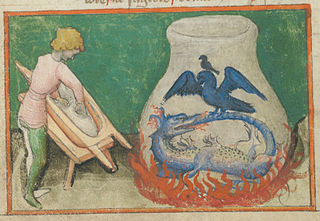
Alchemy is an ancient branch of natural philosophy, a philosophical and protoscientific tradition that was historically practiced in China, India, the Muslim world, and Europe. In its Western form, alchemy is first attested in a number of pseudepigraphical texts written in Greco-Roman Egypt during the first few centuries AD.

Rosicrucianism is a spiritual and cultural movement that arose in Europe in the early 17th century after the publication of several texts announcing to the world a new esoteric order. Rosicrucianism is symbolized by the Rosy Cross or Rose Cross.
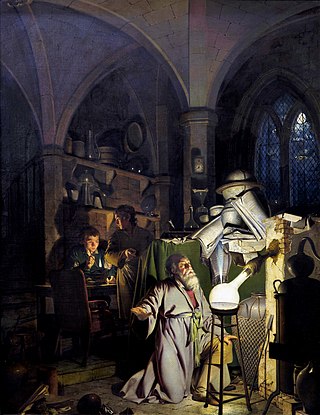
The philosopher's stone is a mythic alchemical substance capable of turning base metals such as mercury into gold or silver. It is also called the elixir of life, useful for rejuvenation and for achieving immortality; for many centuries, it was the most sought-after goal in alchemy. The philosopher's stone was the central symbol of the mystical terminology of alchemy, symbolizing perfection at its finest, divine illumination, and heavenly bliss. Efforts to discover the philosopher's stone were known as the Magnum Opus.

Sir Edward Kelley or Kelly, also known as Edward Talbot, was an English Renaissance occultist and scryer. He is known for working with John Dee in his magical investigations. Besides the professed ability to see spirits or angels in a "shew-stone" or mirror, which John Dee so valued, Kelley also said that he possessed the secret of transmuting base metals into gold, the goal of alchemy, as well as the philosopher's stone itself.
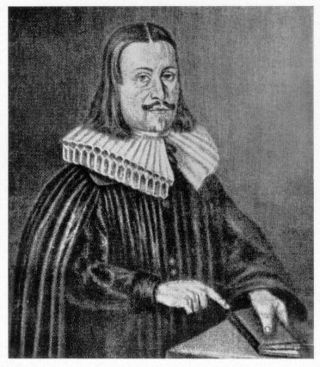
Andreas Libavius or Andrew Libavius was born in Halle, Germany c. 1550 and died in July 1616. Libavius was a renaissance man who spent time as a professor at the University of Jena teaching history and poetry. After which he became a physician at the Gymnasium in Rothenburg and later founded the Gymnasium at Coburg. Libavius was most known for practicing alchemy and writing a book called Alchemia, one of the first chemistry textbooks ever written.

In Renaissance alchemy, alkahest was the theorized "universal solvent". It was supposed to be capable of dissolving any other substance, including gold, without altering or destroying its fundamental components.

The Emerald Tablet, also known as the Smaragdine Tablet or the Tabula Smaragdina, is a compact and cryptic Hermetic text. It was highly regarded by Islamic and European alchemists as the foundation of their art. Though attributed to the legendary Hellenistic figure Hermes Trismegistus, the text of the Emerald Tablet first appears in a number of early medieval Arabic sources, the oldest of which dates to the late eighth or early ninth century. It was translated into Latin several times in the twelfth and thirteenth centuries. Numerous interpretations and commentaries followed.

Splendor Solis is a version of the illuminated alchemical text attributed to Salomon Trismosin. This version dates from around 1582.

Gerhard Dorn was a Belgian philosopher, translator, alchemist, physician and bibliophile.
Adam McLean is a Scottish writer on alchemical texts and symbolism. In 1978 he founded the Hermetic Journal which he published until 1992 during which time he also started publishing the Magnum Opus Hermetic Sourceworks, a series of 55 editions of key source texts of the hermetic tradition. From 2004 he began collecting tarot cards in order to document tarot art and built up a collection of 2500 items. In 2016 he set up the Surrealism Website in order to document surrealist painters. This currently shows the work of 100 surrealist artists. He also created a series of 20 video lectures on many facets of surrealist paintings. In 2017 he set up an art gallery The Studio and Gallery in Kilbirnie in North Ayrshire in order to promote the work of emergent and lesser-known artists.
George Starkey (1628–1665) was a Colonial American alchemist, medical practitioner, and writer of numerous commentaries and chemical treatises that were widely circulated in Western Europe and influenced prominent men of science, including Robert Boyle and Isaac Newton. After relocating from New England to London, England, in 1650, Starkey began writing under the pseudonym Eirenaeus Philalethes. Starkey remained in England and continued his career in medicine and alchemy until his death in the Great Plague of London in 1665.
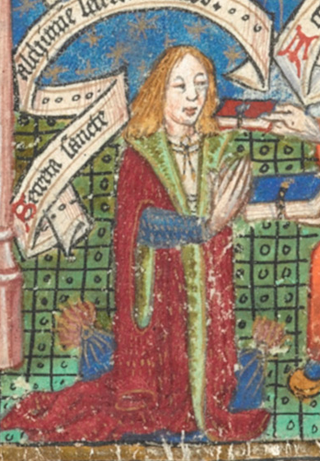
Thomas Norton was an English poet and alchemist best known for his 1477 alchemical poem, The Ordinal of Alchemy.
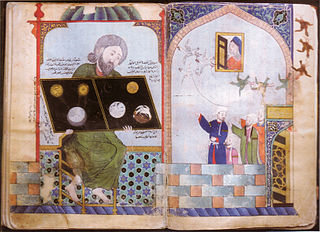
Muḥammad ibn Umayl al-Tamīmī, known in Latin as Senior Zadith, was an early Muslim alchemist who lived from c. 900 to c. 960 AD.
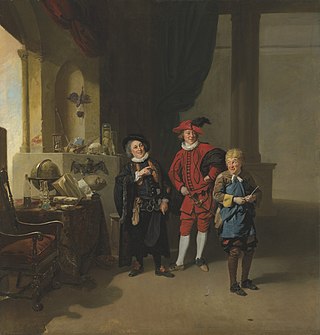
Alchemy has had a long-standing relationship with art, seen both in alchemical texts and in mainstream entertainment. Literary alchemy appears throughout the history of English literature from Shakespeare to modern Fantasy authors. Here, characters or plot structure follow an alchemical magnum opus. In the fourteenth century, Chaucer began a trend of alchemical satire that can still be seen in recent fantasy works like those of Terry Pratchett.
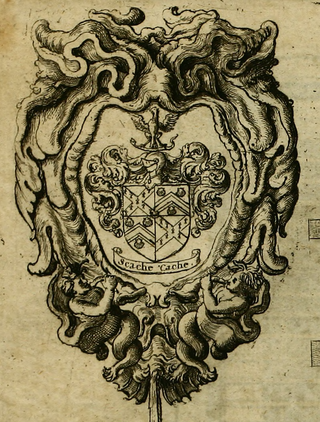
William Backhouse was an English philosopher, alchemist, astrologer, translator, and the esoteric mentor of Elias Ashmole.
The following outline is provided as an overview of and topical guide to alchemy:

The Alchemical Door, also known as the Alchemy Gate or Magic Portal, is a monument built between 1678 and 1680 by Massimiliano Palombara, marquis of Pietraforte, in his residence, the villa Palombara, which was located on the Esquiline hill, near Piazza Vittorio, in Rome. This is the only one of five former gates of the villa that remains; there was a lost door on the opposite side dating them to 1680 and four other lost inscriptions on the walls of the mansion inside the villa.

Hermann Fictuld was a pseudonym used by an early Freemason, whose identity has not been definitely determined. He wrote books on alchemy and on Hermeticism.
Johann of Laz, or Johannes von Laaz, Joannes de Lasnioro, was a Bohemian alchemist during the first half of the fifteenth century.
Alphidius, also known as Asfidus, Alfidius, Alvidius, is the author name of an unknown, probably medieval Arab alchemist. Nothing is known about him, except some citations and his writings in the 14th century.
References
Notes
- ↑ Other variations include Trismosinus and Trissmosin.
Citations
- 1 2 3 4 Södergård, J. Peter (1996). "Decoding the Hermetic Discourse in Salomon Trismosin's Splendor Solis: A Semiotic Study of Three Ways of Reading". Scripta Instituti Donneriani Aboensis. 16: 313–344. doi: 10.30674/scripta.67236 .
- 1 2 Hartmann, Franz (1945) [1st ed. 1887]. The Life and the Doctrines of Philippus Theophrastus Bombast of Hohenheim: Known by the Name of Paracelsus (4th ed.). New York: Macoy Publishing and Masonic Supply Company. p. 6.
- 1 2 Splendor Solis – via M. Moleiro.
- ↑ Skinner, Steven; Prinke, Rafał T.; Hedesan, Georgiana; Godwin, Joscelyn (2019). Splendor Solis: The World's Most Famous Alchemical Manuscript. Watkins Publishing. ISBN 9781786782595.
- 1 2 3 4 "Salomon Trismosin's alchemical wanderings". The Alchemy Web Site.
- 1 2 Waite, Arthur Edward (1921). "The Sun of Alchemy" (PDF). Occult Review. 33 (3): 135–141.
- ↑ Powell, Neil (1976). "The Medieval Masters". Alchemy, the Ancient Science. A New Library of the Supernatural. New York: Doubleday and Company. pp. 54–79.
- 1 2 Patai, Raphael (1994). "Solomon Trismosin and his Jewish Master". The Jewish Alchemists: A History and Source Book. Princeton Legacy Library. Princeton, NJ: Princeton University Press. pp. 268–270. ISBN 9781400863662. JSTOR j.ctt7zvb6p.30.
- 1 2 Long, Kathleen Perry (1995). "Salomon Trismosin and Clovis Hesteau de Nuysement: The Sexual Politics of Alchemy in Early Modern France". L'Esprit Créateur . 35 (2): 9–21. doi:10.1353/esp.1995.0010. S2CID 157256738.
- ↑ "Detailed record for Harley 3469". The British Library: Catalogue of Illuminated Manuscripts.
- ↑ "Splendor Solis images". The Alchemy Web Site.